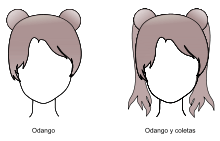Bun (hairstyle)
A bun is a type of hairstyle wherein the hair is pulled back from the face, twisted or plaited, and wrapped in a circular coil around itself, typically on top or back of the head or just above the neck. A bun can be secured with a barrette, bobby pins, one or more hair sticks, a hairnet, or a pen or pencil. Hair may also be wrapped around a piece called a "rat".[1][2] Alternatively, hair bun inserts, or sometimes rolled up socks, may also be used to create donut-shaped buns.[3] Buns may be tightly gathered, or loose and more informal.
Double bun

Double or pigtail buns are often called odango (お団子 odango) , which is also a type of Japanese dumpling (usually called dango; the o- is honorific).
The term was popularized by the anime and manga series Sailor Moon , whose eponymous heroine, her mother during the Ancient Silver Millennium, Queen Serenity, and her future daughter from the 30th Century Silver Millennium, Chibiusa (although Chibiusa's are more conical than spherical), all wear their hair in this style. They also wear two pigtails of hair that hang down from the two spherical buns, but this is not universal to the term's usage within Japan, itself. The term odango in Japanese can refer to any variety of bun hairstyle.
In China, the hairstyle is called niújiǎotóu (牛角头).[4] It was a commonly used hairstyle up until the early 20th century, and can still be seen today when traditional attire is used. This hairstyle differs from the odango slightly in that it is gender neutral; Chinese paintings of children have frequently depicted girls as having matching ox horns, while boys have a single bun in the back.
Man bun
Man buns were worn in China as early as 200BC as depicted on the terracotta soldiers. They were worn until the end of the Ming Dynasty in 1644AD, after which the Qing Dynasty government enforced Han Chinese to adopt the queue hairstyle (queue order).

_warior_with_bun_hairstyle.jpg)
The term "man bun" is a term used to describe long-haired men who do not wish to sport the traditional trend of short back and sides wearing their hair in a topknot. It originated in 16th century Japan as the traditional hairstyle for samurai warriors and sumo wrestlers, and became a fad in Britain and the US during the mid 2010s due to its association with wuxia and samurai films.[5] Men with long hair tend to use this style for practicality and heat relief rather than a particular fashion or trend. [6]
The dating website WhatsYourPrice surveyed over 67,400 women and broke down their findings by age and demographic. The results claim 82% of women between the ages of 18 and 24 found the man bun attractive, while women over the age of 35 were least in favor of the updo, with only 37% of them reacting positively to the style. The man bun began to grow in popularity in 2013.[7]
Historical and iconic examples of men with long hair using this style as practicality include:
- Shiva
- 6th-7th century BCE — Buddha
- 3rd century BCE—Terracotta Warriors of China
- Gareth Bale
- David Beckham
- Bradley Cooper[8][9][10][11]
- Leonardo DiCaprio
- Josh Donaldson
- Colin Farrell
- Kit Harington
- George Harrison, in the 1970s
- Andrew Hozier-Byrne
- Zlatan Ibrahimovic
- Jared Leto
- Jeremy Lin
- Clay Matthews III
- Joakim Noah
- Jared Padalecki
- Brad Pitt
- Harry Styles
See also
References
- ↑ "Hair Rats: Creating Voluminous, Perfect Buns". Bouffants and Beehives. August 3, 2012.
- ↑ "Hair Rats". Pin Curl Magazine. May 1, 2010.
- ↑ "Rise of the 'sock bun': How to master the hipster updo that is fast becoming the height of hair fashion". Mail Online. Retrieved 2016-11-24.
- ↑ "颜值自信者请进!学扎明星同款牛角头". 爱美女性网. Retrieved 19 October 2016.
- ↑ samurai hairstyle
- ↑ http://www.nydailynews.com/life-style/fashion/knotty-issue-man-bun-article-1.1518743
- ↑ http://uk.complex.com/style/2015/03/new-study-proves-women-love-man-buns
- ↑ http://www.betcheslovethis.com/slideshow/the-five-best-man-buns-in-sports
- ↑ http://okmagazine.com/be-pretty/hair-how-tos/trending-now-the-man-bun/
- ↑ http://www.theguardian.com/commentisfree/2014/dec/21/man-buns-hairdo-2014
- ↑ http://www.buzzfeed.com/elliewoodward/everything-is-better-with-a-bun
External links
![]() Media related to Bun hairstyle at Wikimedia Commons
Media related to Bun hairstyle at Wikimedia Commons